Dec 23, 2025
Dec 23, 2025
The 1960s – Golden Years – Part 15
Entertainers (1965-67) Continued
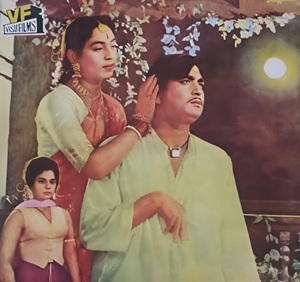 Khandan, directed by A Bhimsingh and starring Sunil Dutt, Nutan, Om Prakash, Lalita Pawar, and Pran, is the remake of Bhimsingh’s Tamil film Bhaaga Pirivinai, also remade earlier in Telugu as Manchi Manasuku Manchi Rojulu. Sunil Dutt plays a physically disabled person who wants to live a normal life. T
Khandan, directed by A Bhimsingh and starring Sunil Dutt, Nutan, Om Prakash, Lalita Pawar, and Pran, is the remake of Bhimsingh’s Tamil film Bhaaga Pirivinai, also remade earlier in Telugu as Manchi Manasuku Manchi Rojulu. Sunil Dutt plays a physically disabled person who wants to live a normal life. T
he story, about relationships in a rural family, follows the tested South Indian formula prevalent at the time, with stock characters, melodrama, mushy sentimentality, and good songs. Sunil Dutt, Nutan, Lalita Pawar, and Pran gave very good performances.
Ravi’s music won him the Filmfare Award for Best Music Director in 1966, and Rajinder Krishan and Lata Mangeshkar won Awards for Best Lyricist and Best Singer, respectively, for Tumhi meri mandir tumhi meri puja.
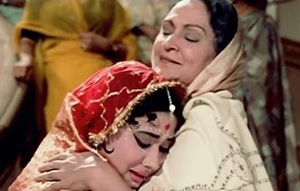 Kaajal, directed by Ram Maheshwari, is a romantic drama starring Meena Kumari, Raaj Kumar, Dharmendra, and Padmini. The film’s music was composed by Ravi. The film is based on Gulshan Nanda's Hindi novel Maadhavi. Gulshan Nanda was a phenomenally popular writer of “pocketbooks”, the cheaply printed and low-priced Hindi novels that sold in staggering numbers at bookstalls, railway stations, bus depots, and lending libraries in the 1960s and ’70s. Nanda specialized in the “social” novel, which had love, romance, drama, family relationships, but also, often, mystery and suspense. His books were full of familiar Hindi film characters, situations, and events. They were often inspired by foreign works. He wrote over 50 books, many of which were made into films. Kaajal was his second film after Phoolon Ki Sej (1964). The story is a complicated mixture of tragedy, coincidence, jealousy, and intrigue that seems quite incredible, but good acting and good music save the film. Sahir Ludhianvi’s lyrics are as good in the bhajan Tora man darpan kehlaye, sung by Asha Bhonsle, as in the ghazals Chhoo Lene Do and Yeh Zulf Agar Khulke sung by Mohammed Rafi.
Kaajal, directed by Ram Maheshwari, is a romantic drama starring Meena Kumari, Raaj Kumar, Dharmendra, and Padmini. The film’s music was composed by Ravi. The film is based on Gulshan Nanda's Hindi novel Maadhavi. Gulshan Nanda was a phenomenally popular writer of “pocketbooks”, the cheaply printed and low-priced Hindi novels that sold in staggering numbers at bookstalls, railway stations, bus depots, and lending libraries in the 1960s and ’70s. Nanda specialized in the “social” novel, which had love, romance, drama, family relationships, but also, often, mystery and suspense. His books were full of familiar Hindi film characters, situations, and events. They were often inspired by foreign works. He wrote over 50 books, many of which were made into films. Kaajal was his second film after Phoolon Ki Sej (1964). The story is a complicated mixture of tragedy, coincidence, jealousy, and intrigue that seems quite incredible, but good acting and good music save the film. Sahir Ludhianvi’s lyrics are as good in the bhajan Tora man darpan kehlaye, sung by Asha Bhonsle, as in the ghazals Chhoo Lene Do and Yeh Zulf Agar Khulke sung by Mohammed Rafi.
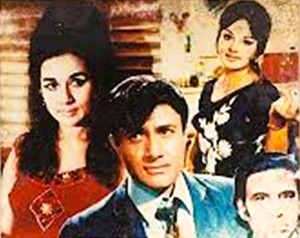 Nav Ketan’s Teen Deviyan, starring Dev Anand, Nanda, Simi Grewal, and Kalpana, tells the story of a poet who falls in love with three women. Nanda, the girl next door, is sweet. Simi, a rich socialite, is elegant and wealthy. Kalpana, a successful actress, hides a sad, lonely heart behind a laughing, flirting exterior. The hero is unable to decide whom to choose as his life partner. Amarjeet is credited with the direction, but it was ghost-directed by Dev Anand. The film’s screenplay lacks direction, and the characters lack depth, as Dev Anand sings and dances with each girl in turn. However, SD Burman gave us some of his most unforgettable tunes like Kishore Kumar’s Khwab ho tum ya koyi haqeeqat, Mohammed Rafi’s Aise to na dekho and Kahin bekhayal ho karChhupa hai teri aankhon mein and Uff kitni thandi hai, and the bubbling Kishore Kumar and Asha Bhonsle’s duet, Are yaar meri tum bhi ho ghazab.
Nav Ketan’s Teen Deviyan, starring Dev Anand, Nanda, Simi Grewal, and Kalpana, tells the story of a poet who falls in love with three women. Nanda, the girl next door, is sweet. Simi, a rich socialite, is elegant and wealthy. Kalpana, a successful actress, hides a sad, lonely heart behind a laughing, flirting exterior. The hero is unable to decide whom to choose as his life partner. Amarjeet is credited with the direction, but it was ghost-directed by Dev Anand. The film’s screenplay lacks direction, and the characters lack depth, as Dev Anand sings and dances with each girl in turn. However, SD Burman gave us some of his most unforgettable tunes like Kishore Kumar’s Khwab ho tum ya koyi haqeeqat, Mohammed Rafi’s Aise to na dekho and Kahin bekhayal ho karChhupa hai teri aankhon mein and Uff kitni thandi hai, and the bubbling Kishore Kumar and Asha Bhonsle’s duet, Are yaar meri tum bhi ho ghazab.
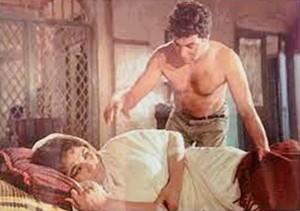 Phool Aur Patthar, directed by OP Ralhan, is regarded as the film that made a star of Dharmendra. Meena Kumari and Dharmendra had acted together in two films earlier, Majhli Didi, in which they had very few scenes together, and Kajal, in which Dharmendra was paired with Padmini while Meena Kumari was paired with Raaj Kumar. In Phool Aur Patthar, Dharmendra and Meena Kumari had more scope to emote together. Dharmendra established his macho image by displaying his bare torso. Phool Aur Patthar relates the story of a thief who rescues and brings home a virtuous widow abandoned by her family when the village is attacked by plague. The thief is reformed by the determined refusal of the widow to live on stolen goods. Neighbours accuse her of loose morals for living with a thief. They are convinced of the change in the thief’s character when he risks his life to save a child in a fire. The thief’s background leading to a life of crime is sketchy, and the widow’s in-laws, played by Lalita Pawar and Jeevan, follow the pattern familiar to viewers. Also familiar are the criminal head and his moll, played by Madan Puri and Shashikala. With a dose of dishum dishums, court scenes, and songs for mass appeal, the film became a superhit, making Dharmendra a superstar. But neither the film nor the songs tuned by Ravi at the peak of his career left a long-term impression. It is only remembered for its poster showing a bare-chested Dharmendra standing behind Meena Kumari in a white saree, lying on her bed, cowering in fear.
Phool Aur Patthar, directed by OP Ralhan, is regarded as the film that made a star of Dharmendra. Meena Kumari and Dharmendra had acted together in two films earlier, Majhli Didi, in which they had very few scenes together, and Kajal, in which Dharmendra was paired with Padmini while Meena Kumari was paired with Raaj Kumar. In Phool Aur Patthar, Dharmendra and Meena Kumari had more scope to emote together. Dharmendra established his macho image by displaying his bare torso. Phool Aur Patthar relates the story of a thief who rescues and brings home a virtuous widow abandoned by her family when the village is attacked by plague. The thief is reformed by the determined refusal of the widow to live on stolen goods. Neighbours accuse her of loose morals for living with a thief. They are convinced of the change in the thief’s character when he risks his life to save a child in a fire. The thief’s background leading to a life of crime is sketchy, and the widow’s in-laws, played by Lalita Pawar and Jeevan, follow the pattern familiar to viewers. Also familiar are the criminal head and his moll, played by Madan Puri and Shashikala. With a dose of dishum dishums, court scenes, and songs for mass appeal, the film became a superhit, making Dharmendra a superstar. But neither the film nor the songs tuned by Ravi at the peak of his career left a long-term impression. It is only remembered for its poster showing a bare-chested Dharmendra standing behind Meena Kumari in a white saree, lying on her bed, cowering in fear.
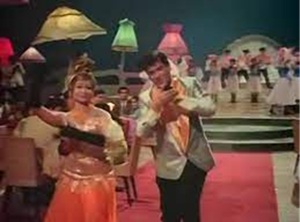 Teesri Manzil, produced by Nasir Hussain and directed by Vijay Anand, is a musical mystery thriller starring Shammi Kapoor and Asha Parekh, with music by RD Burman. Dev Anand was originally signed up for the leading man’s role, but he left after differences with Nasir Hussain. Shammi Kapoor was unsure of Vijay Anand’s ability to direct the film and complained to the producer but eventually acknowledged Vijay Anand’s talent. Likewise, Shammi Kapoor wanted Shankar Jaikishan as the music directors but was convinced after hearing the tune of Aaja aaja. Asha Bhonsle recalls that she had practiced for eight days to get the correct intonation of aaja aaja ahaha aaja in the song. Premnath, after an unsuccessful career as a leading man, played a negative role, which he had last played in Aan (1952), beginning a new successful innings as a villain. Vijay Anand’s terse direction and a brilliant music score made Teesri Manzil a huge success at the box office. It was the first major success for music director RD Burman. Deewana mujhsa nahin and Tumne mujhe dekha hokar meherban, sung by Mohammed Rafi, O mere sona re sona, sung by Asha Bhonsle, and Mohammed Rafi and Asha Bhonsle’s duets O haseena zulfonwali jane jahan and Aaja aaja main hoon pyar tera, were all featured in the annual list of Binaca Geetmala. Shammi Kapoor went through a personal tragedy during the filming of Teesri Manzil. Geeta Bali, whom Shammi had married in 1955 during the shooting of Rangeen Raaten, died of smallpox suddenly, merely two weeks after she got the malady. Shooting had to be stopped for a couple of months. When it was resumed, Shammi shot for the song Tumne mujhe dekha. His acting in the song is very emotional. During the song sequence, a three-candle stand on Asha Parekh's table falls over, and the candles are extinguished. Shammi Kapoor relights them, leaving the middle candle unlit. This was Shammi Kapoor's way of showing that the light in his life had been put out.
Teesri Manzil, produced by Nasir Hussain and directed by Vijay Anand, is a musical mystery thriller starring Shammi Kapoor and Asha Parekh, with music by RD Burman. Dev Anand was originally signed up for the leading man’s role, but he left after differences with Nasir Hussain. Shammi Kapoor was unsure of Vijay Anand’s ability to direct the film and complained to the producer but eventually acknowledged Vijay Anand’s talent. Likewise, Shammi Kapoor wanted Shankar Jaikishan as the music directors but was convinced after hearing the tune of Aaja aaja. Asha Bhonsle recalls that she had practiced for eight days to get the correct intonation of aaja aaja ahaha aaja in the song. Premnath, after an unsuccessful career as a leading man, played a negative role, which he had last played in Aan (1952), beginning a new successful innings as a villain. Vijay Anand’s terse direction and a brilliant music score made Teesri Manzil a huge success at the box office. It was the first major success for music director RD Burman. Deewana mujhsa nahin and Tumne mujhe dekha hokar meherban, sung by Mohammed Rafi, O mere sona re sona, sung by Asha Bhonsle, and Mohammed Rafi and Asha Bhonsle’s duets O haseena zulfonwali jane jahan and Aaja aaja main hoon pyar tera, were all featured in the annual list of Binaca Geetmala. Shammi Kapoor went through a personal tragedy during the filming of Teesri Manzil. Geeta Bali, whom Shammi had married in 1955 during the shooting of Rangeen Raaten, died of smallpox suddenly, merely two weeks after she got the malady. Shooting had to be stopped for a couple of months. When it was resumed, Shammi shot for the song Tumne mujhe dekha. His acting in the song is very emotional. During the song sequence, a three-candle stand on Asha Parekh's table falls over, and the candles are extinguished. Shammi Kapoor relights them, leaving the middle candle unlit. This was Shammi Kapoor's way of showing that the light in his life had been put out.
Yeh Raat Phir Na Aayegi, directed by Brij Sadanah, starring Sharmila Tagore, Biswajit, and Mumtaz, is a fantasy that taxes the intelligence of the viewers. The film tells the story of a woman murdered two thousand years ago, who suddenly turns up at an archaeological site to claim her lover! OP Nayyar’s tunes and beautiful cinematography helped to make the film a hit. Yehi woh jaga hai, Har tukda mere dil ka, and Main shayad tumhare, sung by Asha Bhonsle, and her duet with Mohammed Rafi, Phir miloge kabhi, were popular.
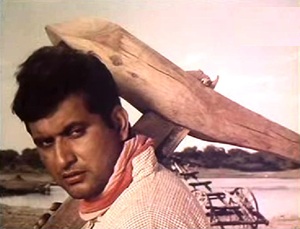 Upkar was the first film directed by Manoj Kumar. He also wrote the story based on Prime Minister Lal Bahadur Shastri’s slogan Jai Jawan Jai Kisan. The film starred Asha Parekh, Manoj Kumar, Prem Chopra, Pran, and Kamini Kaushal. Kalyanji-Anandji provided the music for the film. Manoj Kumar’s story had too much on one plate in the guise of patriotism. Lal Bahadur Shastri’s slogan was meant to highlight the importance of soldiers in the defence of the country and of farmers in maintaining its economy. In Upkar, Manoj Kumar is named Bharat and is a farmer and a soldier by turns, spouting patriotic dialogues. The plot is full of masala clichés exposing the pseudo-patriotism of the filmmaker. The film drew crowds, however, becoming the highest-grossing movie of 1967. Kalyanji-Anandji’s music and a sterling performance by Pran contributed to the success of the film. Mahendra Kapoor’s Mere Desh ki dharti, one of the most popular patriotic songs, Manna Dey’s powerfully rendered Kasme wade, and Lata Mangeshkar’s Har Khushi ho wahan are memorable songs. Upkar won seven Filmfare Awards, including for Best Film, Best Director, Story and Dialogues for Manoj Kumar, Best Supporting Actor for Pran, and Best Lyricist for Gulshan Bawra for Jis desh ki dharti. It also won the National Film Award for Second Best Feature Film.
Upkar was the first film directed by Manoj Kumar. He also wrote the story based on Prime Minister Lal Bahadur Shastri’s slogan Jai Jawan Jai Kisan. The film starred Asha Parekh, Manoj Kumar, Prem Chopra, Pran, and Kamini Kaushal. Kalyanji-Anandji provided the music for the film. Manoj Kumar’s story had too much on one plate in the guise of patriotism. Lal Bahadur Shastri’s slogan was meant to highlight the importance of soldiers in the defence of the country and of farmers in maintaining its economy. In Upkar, Manoj Kumar is named Bharat and is a farmer and a soldier by turns, spouting patriotic dialogues. The plot is full of masala clichés exposing the pseudo-patriotism of the filmmaker. The film drew crowds, however, becoming the highest-grossing movie of 1967. Kalyanji-Anandji’s music and a sterling performance by Pran contributed to the success of the film. Mahendra Kapoor’s Mere Desh ki dharti, one of the most popular patriotic songs, Manna Dey’s powerfully rendered Kasme wade, and Lata Mangeshkar’s Har Khushi ho wahan are memorable songs. Upkar won seven Filmfare Awards, including for Best Film, Best Director, Story and Dialogues for Manoj Kumar, Best Supporting Actor for Pran, and Best Lyricist for Gulshan Bawra for Jis desh ki dharti. It also won the National Film Award for Second Best Feature Film.
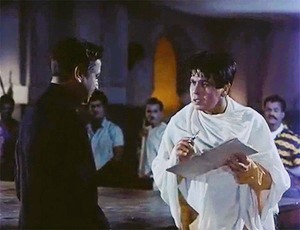 Ram Aur Shyam, produced by well-known South Indian producers Chakrapani and Nagi Reddy for Vijaya Productions, and directed by Tapi Chanakya, was a remake of their Telugu megahit Ramudu Bhimudu. DV Narasu Raju wrote the story of Ramudu Bhimudu, inspired by Anthony Hope’s Prisoner of Zenda and Daphne Du Maurier’s Scapegoat. The theme of identical twins separated at birth was used in Indian films several times, both before and after Ram Aur Shyam. Gemini’s Tamil film Apoorva Sagodharagal (1949), starring Ranjan, was based on Corsican Brothers by Alexander Dumas. It was simultaneously made in Hindi as Nishan. Bengali film Tasher Ghar (1957) remade in Telugu as Iddaru Mitrulu (1961), was an adaptation of Scapegoat. The story of Tasher Ghar is credited to Rash Behari Lal, while that of Iddaru Mitrulu is credited to Telugu journalist and writer Gora Sastri. Later films were Ramesh Sippy’s Seeta Aur Geeta (1972) and Pankaj Parasher’s Chalbaaz (1989), both of which had female twins instead of male twins. DV Narasu Raju (Ram Aur Shyam), Salim-Javed (Sita Aur Geeta), and Rajesh Mazumdar and Kamlesh Pandey (Chaalbaz) followed the script of Tasher Ghar with minor variations, especially as required for a female protagonist. Ram Aur Shyam stars Dilip Kumar in a double role for the first time, with Waheeda Rehman and Mumtaz opposite him. Pran and Nirupa Roy played important roles, and Naushad provided the music for the film.
Ram Aur Shyam, produced by well-known South Indian producers Chakrapani and Nagi Reddy for Vijaya Productions, and directed by Tapi Chanakya, was a remake of their Telugu megahit Ramudu Bhimudu. DV Narasu Raju wrote the story of Ramudu Bhimudu, inspired by Anthony Hope’s Prisoner of Zenda and Daphne Du Maurier’s Scapegoat. The theme of identical twins separated at birth was used in Indian films several times, both before and after Ram Aur Shyam. Gemini’s Tamil film Apoorva Sagodharagal (1949), starring Ranjan, was based on Corsican Brothers by Alexander Dumas. It was simultaneously made in Hindi as Nishan. Bengali film Tasher Ghar (1957) remade in Telugu as Iddaru Mitrulu (1961), was an adaptation of Scapegoat. The story of Tasher Ghar is credited to Rash Behari Lal, while that of Iddaru Mitrulu is credited to Telugu journalist and writer Gora Sastri. Later films were Ramesh Sippy’s Seeta Aur Geeta (1972) and Pankaj Parasher’s Chalbaaz (1989), both of which had female twins instead of male twins. DV Narasu Raju (Ram Aur Shyam), Salim-Javed (Sita Aur Geeta), and Rajesh Mazumdar and Kamlesh Pandey (Chaalbaz) followed the script of Tasher Ghar with minor variations, especially as required for a female protagonist. Ram Aur Shyam stars Dilip Kumar in a double role for the first time, with Waheeda Rehman and Mumtaz opposite him. Pran and Nirupa Roy played important roles, and Naushad provided the music for the film.
Vyjayantimala was originally signed up for the film, but after shooting for about eight days, she noticed a change in the attitude of people on the set. Becoming suspicious, she made enquiries and learnt from a friend that she had been replaced by Waheeda Rehman at the instance of Dilip Kumar. Starting with Bimal Roy’s Devdas, through Naya Daur, Madhumati, and Ganga Jamuna, Vyjayantimala was considered a Dilip Kumar loyalist until she signed up for Raj Kapoor’s Sangam. She was simultaneously shooting for Subodh Mukherjee’s Leader opposite Dilip Kumar. The inevitable clash of dates for shooting followed. The media was flush with rumours of an affair between Raj Kapoor and Vyjayantimala. The Dilip Kumar camp seems to have taken this seriously. Vyjayantimala was accused of being non-cooperative and of throwing tantrums on the sets, and the rest followed. When the shooting of Sangam was completed, Vyjayantimala married Dr Chamanlal Bali, but the damage had been done. Vyjayantimala and Dilip Kumar stopped talking to each other, although they agreed to complete HS Rawail’s Sunghursh, which was nearly completed when the rift occurred.
Dilip Kumar is superb as Ram and Shyam, two very different men, and is funny as both. The story and screenplay are good with no unnecessary digressions, no comic side plots, and an engaging pace. Naushad’s music for Ram aur Shyam is also very good, with Aayi hain bahaarein mite zulm-o-sitam, Aaj ki raat mere dil ki salaami le le sung by Mohammed Rafi and his duet with Lata Mangeshkar, Baalam tere pyaar ki thandi aag mein jalte-jalte, becoming hits.
02-Aug-2025
More by : Ramarao Annavarapu

|
Great films of yesteryear !! I still remember watching Upkar when it was released in the 60s. We lived in Gorakhpur then, and I was studying in a convent school. All four of us, father , mother, everyone sat in a rickshaw which trundled along taking us to a movie hall, maybe United Talkies. Many of Gorakhpurs talkies were situated on a single road, which was therefore named Cinema Road. Well, being young I couldnt enjoy much, but In later years I watched Upkar again. It was a great movie. |